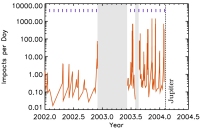Ulysses Sweeps up Dust From Jupiter
The dust streams, comprising grains no larger than smoke particles, originate in the fiery volcanoes of Jupiter's moon Io. The dust stream particles, which carry an electric charge, are strongly influenced by Jupiter's magnetic field. Electromagnetic forces propel the dust out of the Jovian system, into interplanetary space.
 |
|
The impact rate of small dust particles recorded by the DUST instrument on board Ulysses. |
Early on in the history of the solar system, as the planets were being formed, small dust particles were much more abundant. These charged grains were influenced by magnetic fields from the early Sun, in much the same way as the dust from Io is affected by Jupiter's magnetic field today. "By studying the behaviour of these dust stream particles, we hope to gain an insight into processes that led to the formation of the moons and planets in our solar system", said Richard Marsden, ESA's Mission Manager for Ulysses. Dust particles carry information about charging processes in regions of Jupiter's magnetosphere that are difficult to access by other means.

